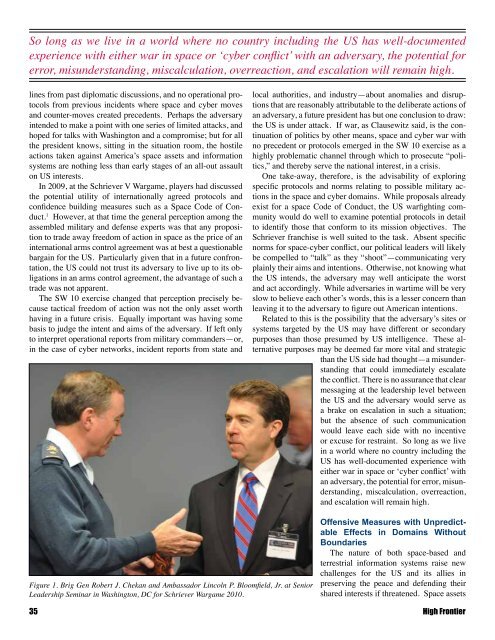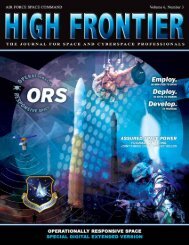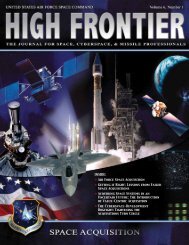Schriever Wargame 2010 - Air Force Space Command
Schriever Wargame 2010 - Air Force Space Command
Schriever Wargame 2010 - Air Force Space Command
- No tags were found...
You also want an ePaper? Increase the reach of your titles
YUMPU automatically turns print PDFs into web optimized ePapers that Google loves.
So long as we live in a world where no country including the US has well-documented<br />
experience with either war in space or ‘cyber conflict’ with an adversary, the potential for<br />
error, misunderstanding, miscalculation, overreaction, and escalation will remain high.<br />
lines from past diplomatic discussions, and no operational protocols<br />
from previous incidents where space and cyber moves<br />
and counter-moves created precedents. Perhaps the adversary<br />
intended to make a point with one series of limited attacks, and<br />
hoped for talks with Washington and a compromise; but for all<br />
the president knows, sitting in the situation room, the hostile<br />
actions taken against America’s space assets and information<br />
systems are nothing less than early stages of an all-out assault<br />
on US interests.<br />
In 2009, at the <strong>Schriever</strong> V <strong>Wargame</strong>, players had discussed<br />
the potential utility of internationally agreed protocols and<br />
confidence building measures such as a <strong>Space</strong> Code of Conduct.<br />
1 However, at that time the general perception among the<br />
assembled military and defense experts was that any proposition<br />
to trade away freedom of action in space as the price of an<br />
international arms control agreement was at best a questionable<br />
bargain for the US. Particularly given that in a future confrontation,<br />
the US could not trust its adversary to live up to its obligations<br />
in an arms control agreement, the advantage of such a<br />
trade was not apparent.<br />
The SW 10 exercise changed that perception precisely because<br />
tactical freedom of action was not the only asset worth<br />
having in a future crisis. Equally important was having some<br />
basis to judge the intent and aims of the adversary. If left only<br />
to interpret operational reports from military commanders—or,<br />
in the case of cyber networks, incident reports from state and<br />
local authorities, and industry—about anomalies and disruptions<br />
that are reasonably attributable to the deliberate actions of<br />
an adversary, a future president has but one conclusion to draw:<br />
the US is under attack. If war, as Clausewitz said, is the continuation<br />
of politics by other means, space and cyber war with<br />
no precedent or protocols emerged in the SW 10 exercise as a<br />
highly problematic channel through which to prosecute “politics,”<br />
and thereby serve the national interest, in a crisis.<br />
One take-away, therefore, is the advisability of exploring<br />
specific protocols and norms relating to possible military actions<br />
in the space and cyber domains. While proposals already<br />
exist for a space Code of Conduct, the US warfighting community<br />
would do well to examine potential protocols in detail<br />
to identify those that conform to its mission objectives. The<br />
<strong>Schriever</strong> franchise is well suited to the task. Absent specific<br />
norms for space-cyber conflict, our political leaders will likely<br />
be compelled to “talk” as they “shoot”—communicating very<br />
plainly their aims and intentions. Otherwise, not knowing what<br />
the US intends, the adversary may well anticipate the worst<br />
and act accordingly. While adversaries in wartime will be very<br />
slow to believe each other’s words, this is a lesser concern than<br />
leaving it to the adversary to figure out American intentions.<br />
Related to this is the possibility that the adversary’s sites or<br />
systems targeted by the US may have different or secondary<br />
purposes than those presumed by US intelligence. These alternative<br />
purposes may be deemed far more vital and strategic<br />
than the US side had thought—a misunderstanding<br />
that could immediately escalate<br />
the conflict. There is no assurance that clear<br />
messaging at the leadership level between<br />
the US and the adversary would serve as<br />
a brake on escalation in such a situation;<br />
but the absence of such communication<br />
would leave each side with no incentive<br />
or excuse for restraint. So long as we live<br />
in a world where no country including the<br />
US has well-documented experience with<br />
either war in space or ‘cyber conflict’ with<br />
an adversary, the potential for error, misunderstanding,<br />
miscalculation, overreaction,<br />
and escalation will remain high.<br />
Figure 1. Brig Gen Robert J. Chekan and Ambassador Lincoln P. Bloomfield, Jr. at Senior<br />
Leadership Seminar in Washington, DC for <strong>Schriever</strong> <strong>Wargame</strong> <strong>2010</strong>.<br />
Offensive Measures with Unpredictable<br />
Effects in Domains Without<br />
Boundaries<br />
The nature of both space-based and<br />
terrestrial information systems raise new<br />
challenges for the US and its allies in<br />
preserving the peace and defending their<br />
shared interests if threatened. <strong>Space</strong> assets<br />
35 High Frontier











